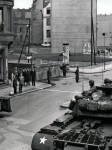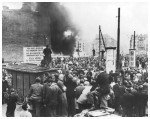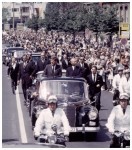
The Berlin crisis unfolded in the 1950s. The German capital had become a divided microcosm of the Cold War. East Berlin was controlled by the communist government of East Germany, while the western half of the city was occupied and supplied by the United States and its allies. Life in Berlin’s communist section was beset with problems. Though a large number of East Berliners supported communism after the war, many became disillusioned with its lack of progress and freedom. The East German government placed pressure on workers with ambitious production quotas and targets. Essential items like food, clothing and accommodation were subsidised by the government – but there were often shortages or long queues. East Germany’s industrial priorities meant that fewer consumer goods and luxuries were produced. East Germans were always mindful of the Stasi (‘State Security’), one of the Soviet bloc’s largest and most pervasive secret police agencies. From the early 1950s, it was difficult for East Germans to travel to nations beyond the Soviet bloc. The border between East and West Germany was transformed into a line of barbed wire, fortifications and guards, running from Czechoslovakia to the Baltic Sea.
By mid-1953, tensions between East German workers and their government had reached fever pitch. The government demanded increases in work quotas but without any increase in pay. This corresponded with a shortage of foodstuffs and basic consumer goods – including rationing of electricity supplies. In June, several hundred construction workers went on strike in East Berlin, after the government threatened to cut their pay for not meeting production quotas. This strike grew into a mass protest involving around 40,000 people, most calling for a reduction in quotas and some political reforms. In time, the protesters came to demand the removal of the East German government. Police and Soviet troops moved to confront the protestors on Unter den Linden (‘Under the Limes’, a well-known street). The police fired on the crowd, killing at least 55 people, though the actual death toll may have been ten times that amount.

The worsening situation in East Germany convinced many that escape from the Soviet bloc was necessary. West Berlin became a conduit for political refugees from East Germany and other communist nations. The city’s borders were lightly manned in comparison to East Germany’s national borders, so illegal crossings into West Berlin, though still difficult, were quite possible. The better living and working conditions in West Germany drew a steady flow of refugees from the East. By 1950 more than 1.5 million Germans had crossed over to West Berlin; once there they were free to relocate anywhere in West Germany or western Europe. During the 1950s refugee numbers increased annually: from 144,000 (1959) to 199,000 (1960) and 207,000 (1961). The professional classes – doctors, lawyers, teachers, the college-educated in particular – formed a significant portion of westbound refugees. In East Germany and the Soviet Union, there was growing worry about this exodus of Soviet citizens. Of particular concern was the effect that a ‘brain drain’ of educated and skilled workers might have on Soviet bloc countries. In 1958, Soviet leader Nikita Khrushchev issued an ultimatum to the Western powers in Berlin:
“The Soviet Government, guided by a desire to normalize the situation in Berlin in the interest of European peace and in the interest of a peaceful and independent development of Germany, has resolved to effect measures on its part designed to liquidate the occupation regime in Berlin. It hopes that the government of the USA will show a proper understanding of these motives and make a realistic approach to the Berlin question.”

Khrushchev announced that West Germany, America, Britain and France should sign treaties with East Germany to turn over control of West Berlin. He gave the Western allies six months to finalise this. Once Khrushchev’s ultimatum expired, any future access to West Berlin would be entirely a matter for the East German government. Khrushchev’s ultimatum generated headlines – but the western powers called his bluff, declaring their intention to remain in West Berlin, along with an assertion that they had the legal right to do so. When Khrushchev’s ultimatum expired in May 1959, nothing had happened. Khrushchev’s gambit had failed and he was forced to withdraw his demands. Foreign ministers from the four powers met in Geneva in mid-1959 to discuss German reunification, though nothing was agreed. The Berlin situation was further eased in September 1959, when Khrushchev visited the US and met with president Eisenhower.

John F. Kennedy’s election to the US presidency (1960) emboldened Khrushchev, who fired off more implied threats about Berlin. At a summit in Vienna in June 1961, Khrushchev told Kennedy he intended to sign a separate peace treaty with East Germany; one of the implications of this treaty would be the nullification of the old Soviet-Allied agreement guaranteeing road, rail and air access into Berlin. The question of access rights to Berlin would then be up to the East Germans, who would almost certainly revoke access. Kennedy, however, did not back down. In a July 25th address to the nation, the president ordered substantial increases in American intercontinental ballistic missile forces, the addition of five new army divisions, and increases to the nation’s air power and military reserves. He declared a willingness to use American military force to defend its rights to access Berlin:
“So long as the communists insist that they are preparing to end by themselves unilaterally our rights in West Berlin and our commitments to its people, we must be prepared to defend those rights and those commitments. We will at times be ready to talk, if talk will help. But we must also be ready to resist with force, if force is used upon us. Either alone would fail. Together, they can serve the cause of freedom and peace.”
“The Kremlin leader [Khrushchev] had always considered the western city of Berlin a ‘festering sore’ on the German Democratic Republic, but also the ‘testicles of the West’. “Every time I want to make the West scream,” he remarked, “I squeeze Berlin”.
Patrick Major, historian
Early August 1960 saw a flurry of meetings between government representatives and foreign ministers on both sides. The Americans, British and French met in Paris and resolved to ignore Khrushchev’s provocation. To respond to it would invite further Soviet aggression, and possibly war. Khrushchev himself was busy considering a KGB plan to divert American attention from Berlin, by stimulating rebellions and unrest in Africa and Central America. The pivotal decision with regard to Berlin instead came from East Germany. On August 12th, the government there signed an order to seal the border between East and West Berlin. From this seed would spring one of the iconic symbols of the Cold War: the Berlin Wall.

1. By the 1950s East Berlin was tightly controlled by the state, its people deprived of essential and consumer goods.
2. This led to unrest, such as a series of rolling strikes and protests in 1953 demanding reductions in work quotas.
3. Many despairing East Berliners fled the city into West Berlin, the numbers of refugees increasing to 207,000 by 1961.
4. Fearing a ‘brain drain’ of skilled workers, Khrushchev issued a 1958 ultimatum for the US to leave West Berlin.
5. This ultimatum was ignored, however Khrushchev again attempted to pressure the West after the election of John F Kennedy as US president. Kennedy staunchly resisted Khrushchev’s demands and visited Berlin to show solidarity with its people.
Content on this page is © Alpha History 2016. This content may not be republished or distributed without permission. For more information please refer to our Terms of Use.
This page was written by Jennifer Llewellyn, Jim Southey and Steve Thompson. To reference this page, use the following citation:
J. Llewellyn et al, “The Berlin crisis”, Alpha History, accessed [today’s date], https://alphahistory.com/coldwar/berlin-crisis/.
